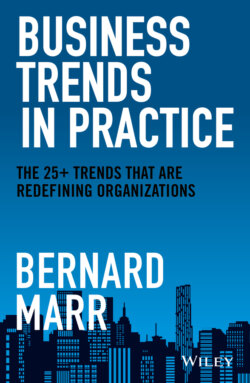Читать книгу Business Trends in Practice - Бернард Марр, Bernard Marr - Страница 10
Trend 1: Our Changing Relationship with Our Planet
ОглавлениеTo put it mildly, we've not had the best relationship with our planet. We've chopped down forests, burnt carbon, dug mines, polluted waterways – all in the name of growing prosperity. For Western countries at least, this has paid off. Using our natural resources has led to greater prosperity. But it has also led to climate change, the collapse of ecosystems and loss of biodiversity, chemical and plastic pollution, and the decline of our natural resources (particularly water). As a result, our planet is under immense pressure and showing the strain through abnormal weather patterns and natural disasters, which, in turn, create pressures around crop production, food security, migration, and more.
Some food for thought on the emerging climate crisis:
Climate change is happening so quickly, many species are struggling to adapt. The Intergovernmental Panel on Climate Change says that a 1.5°C average rise in global average surface temperature may put up to 30 percent of species at risk of extinction. Push that up to 2°C and most ecosystems will struggle.1 For context, the temperature has already increased by 0.9°C since 1906 (the figure is even higher in polar regions).2
By the end of this century, 150–200 million people could be forced to migrate from land that will be underwater.3
Some of the biggest sectors in terms of greenhouse gas emissions include agriculture and forestry (responsible for 18.4 percent of global emissions), energy use in industry (24.2 percent), energy use in buildings (17.5 percent), and transportation (16.2 percent).4
Our precious resources are under enormous pressure. Fresh water makes up just 2.5 percent of the world's total volume of water (and half of that is ice). So it's perhaps no wonder that 1.8 billion people are already living with water scarcity. Even more worryingly, 5.2 billion people are expected to face water stress by 2025.5
Competition for land (particularly land for agriculture) is also growing, and many countries such as China and Saudi Arabia are already pursuing land in Africa. Global competition for finite resources, including land and water, is only going to increase as the population grows.
There may also be a global fight for rare earths, some of the most important minerals and metals found in the ground, which are used in everything from lithium-ion batteries to electric cars. The US is 80 percent reliant on China (the world's biggest rare earths producer) for rare earth imports, and this could lead to further strains on political relationships in future.6
To keep pace with the growing population (I talk more about global demographics later in the chapter), an often-quoted statistic is that we'll have to double crop and animal production by 2050. More conservative estimates suggest that, as food production has already increased in recent years, we may only need to increase production by between 26 percent and 68 percent by 2050.7 But that's still a significant increase to accommodate on an already struggling planet.
Plastic pollution is another pressing concern. Single-use plastics account for 40 percent of the plastic produced every year, meaning something that may be used for mere minutes ends up hanging around for hundreds of years. Every year, around 8 million tons of plastic waste finds its way into the oceans (the equivalent of five garbage bags of trash being placed on every foot of coastline around the world), and with plastic production expected to double by 2050, the problem is set to get a lot worse.8
If our relationship with our planet was a romantic one, it would be labeled “toxic.” Earth's best friends would probably be telling her she could do better. And we must do better. We need to build a more balanced, sustainable relationship with our planet.
Yet the emerging climate disaster is probably the biggest challenge we've ever faced. So how do we overcome something of this magnitude? In his book How to Avoid a Climate Disaster, Bill Gates says that we're adding 51 billion tons of greenhouse gases to the atmosphere every year. To stop global warming and avoid the worst impacts of climate change, Gates says we need to get that number down to zero by 2050. Let me say that again: zero.
The problem, of course, is that most zero-carbon energy solutions cost more than their fossil fuel counterparts. (Gates refers to the price difference as “Green Premiums.”) He says that using Green Premiums as a decision-making tool can help us decide which zero-carbon solutions should be deployed now, which nongreen goods should be priced higher, and where we need to invest in new innovations because the current zero-carbon alternatives aren't cheap enough. (Some of the innovations Gates promotes include nuclear fusion, sea-based carbon removal, and direct air capture of carbon.)
Gates's book is a fascinating read and I urge everyone to read it. But while he has brilliant and practical ideas, we can't ignore the fact that solving the climate crisis is a global responsibility, requiring countries to work together and take collective action. The fact that global economic and political power structures are also undergoing huge changes will only make the job harder. This leads us to the next topic.
